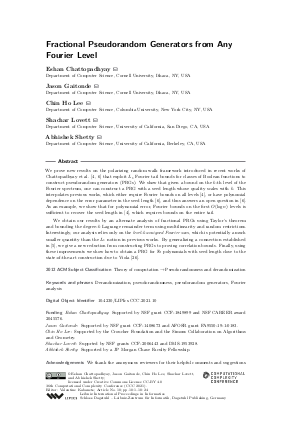LIPIcs.CCC.2021.10.pdf
- Filesize: 0.8 MB
- 24 pages

 Creative Commons Attribution 4.0 International license
Creative Commons Attribution 4.0 International license

We prove new results on the polarizing random walk framework introduced in recent works of Chattopadhyay et al. [Chattopadhyay et al., 2019; Eshan Chattopadhyay et al., 2019] that exploit L₁ Fourier tail bounds for classes of Boolean functions to construct pseudorandom generators (PRGs). We show that given a bound on the k-th level of the Fourier spectrum, one can construct a PRG with a seed length whose quality scales with k. This interpolates previous works, which either require Fourier bounds on all levels [Chattopadhyay et al., 2019], or have polynomial dependence on the error parameter in the seed length [Eshan Chattopadhyay et al., 2019], and thus answers an open question in [Eshan Chattopadhyay et al., 2019]. As an example, we show that for polynomial error, Fourier bounds on the first O(log n) levels is sufficient to recover the seed length in [Chattopadhyay et al., 2019], which requires bounds on the entire tail. We obtain our results by an alternate analysis of fractional PRGs using Taylor’s theorem and bounding the degree-k Lagrange remainder term using multilinearity and random restrictions. Interestingly, our analysis relies only on the level-k unsigned Fourier sum, which is potentially a much smaller quantity than the L₁ notion in previous works. By generalizing a connection established in [Chattopadhyay et al., 2020], we give a new reduction from constructing PRGs to proving correlation bounds. Finally, using these improvements we show how to obtain a PRG for 𝔽₂ polynomials with seed length close to the state-of-the-art construction due to Viola [Emanuele Viola, 2009].






Feedback for Dagstuhl Publishing